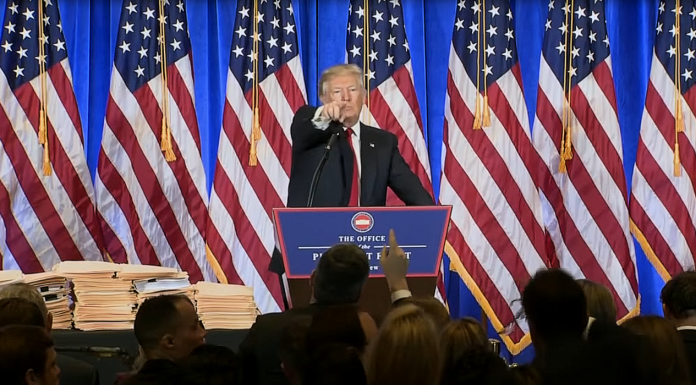In a recent smear campaign to promote the unsubstantiated narrative that President Donald Trump’s rallies were spreading the coronavirus, CNN offered a unique glimpse into how fake news is created.
It all began on Tuesday, when the Center for American Progress—a radical leftist ‘think-tank’ founded by Hillary Clinton surrogate John Podesta—released its encyclical to leftist media everywhere that a new talking point was to emerge: Trump’s rallies spread COVID.
Although the article’s headline made clear its intention, the actual substance proved problematic. The findings in their analysis of 22 rallies showed that only half of the rallies resulted in an actual increase.
Statistically speaking, that meant it was just as likely that Trump rallies reduced the risk of coronavirus as it was that they spread it.
More rational minds, however, might simply conclude that there was little to no correlation between the two.
The claim was debunked in a Tuesday article on Headline USA, which highlighted some of the data undermining CFAP’s claims.
Nonetheless, CNN remained undeterred in its mission to spread the false narrative.
After a day of plotting how to dress up and repackage the misinformation, the leftist network presented its own variation, which reduced the number of rallies in the analysis from 22 to 17.
Missing, it seemed, were five of the less-convenient data sets that helped to discredit its thesis.
“Of the 14 host counties that had increased infection rates, eight of the counties had declining rates of infection in the month before the rally,” said the fake-news outlet. “The other six counties already had increasing rates of infection in that preceding month.”
The CNN article did not explicitly cite CFAP as a source of its study, although the data it drew from appeared to be uncannily similar.
CNN “evaluated the rate of new daily cases per 100,000 residents at four weeks before the rally, on the rally date, and four weeks after the rally at the county level and at the state level.”
CFAP, on the other hand, offered a narrower window, limiting its examination to three-week intervals before and after the rally.
Normal COVID incubation time is believed to be within two weeks. That means CNN’s wider range was less accurate in establishing a direct causal relationship with the Trump rallies as opposed to other mitigating factors (like, perhaps, a Biden rally or a Black Lives Matter protest).
Moreover, CFAP’s data relied on charts following the trends with multiple data points for a six-week span rather than relying on CNN’s process of simply analyzing the numbers at the beginning, middle and end.
CNN also was less transparent in offering the precise details of which rallies it examined, although it provided the date range (Aug. 17 to Sept. 26) and a list of states it examined.
According to its description, that excluded two rallies held prior to the study interval (6/20 in Tulsa, 6/23 in Phoenix) both of which were trending upward before Trump’s rally but went on to stabilize at some point in the two weeks thereafter.
The data also exclude a Sept. 30 rally in Duluth, Minn. Prior to Trump’s visit, numbers there already had begun to rise. That increase may have been linked to a Sept. 18 Joe Biden rally in Duluth, which was notably the Democrat nominee’s first time publicly interacting with a large group of voters in person since the pandemic lock-downs had begun.
Based on the geographic exclusions, it appears CNN also omitted from its analysis a Sept. 25 rally in Newport News, Va. Cases there had dropped significantly prior to Trump’s rally. They saw a minor uptick in the weeks afterward but did not reach their prior level.
The fifth rally excluded from CNN’s cherry-picked data was impossible to determine based on the limited information provided.
Nonetheless, some of the same questionable factors that CFAP employed in its data analysis were present, including the attempt to draw causal conclusions from notably small sample sizes.
While some of the rallies may have been larger and in regions where the COVID outbreak was more severe, most of the so-called increases involved an uptick of just a few people, making it difficult to draw broader conclusions.
CFAP acknowledged, in fact, that many of Trump’s rallies had been located in outdoor airport hangers to help mitigate the spread.
Similar to the CFAP headline, which relied on ambiguous wordage to assert its dubious claim (“Trump Rallies Are Often Followed by Increases in Local COVID-19 Cases”), CNN’s headline remained noncommittal in its word choice (“Many counties that hosted Trump rallies had a significant increase in Covid-19 cases”).
But other outlets that picked up the propaganda subsequently presented the misleading data as hard, statistical fact.
The website for Raleigh, North Carolina’s WRAL modified the CNN piece to indicate that “82% of counties that hosted Trump rallies had a significant increase in coronavirus cases,” as opposed to the prior 50%.
Much like the childhood “Telephone” game (aka Chinese whispers) the talking point now seems to have spun off into a self-perpetuating spiral of distortion.
It would not be surprising before the Nov. 3 election to see other partisan outlets cite the 82% statistic while ignoring its nebulous origin.
And, in time, CFAP may come around to citing it as the authoritative statistic, contrary to what its own data indicate.

